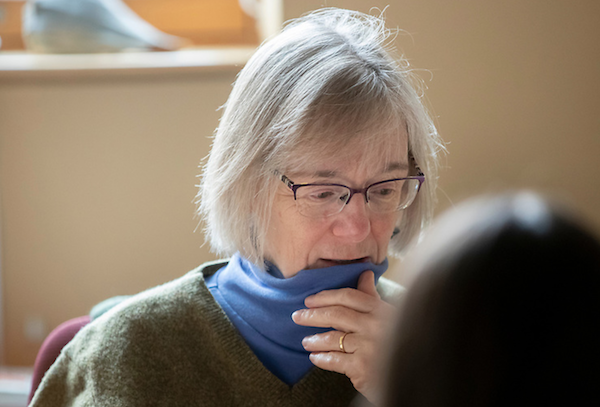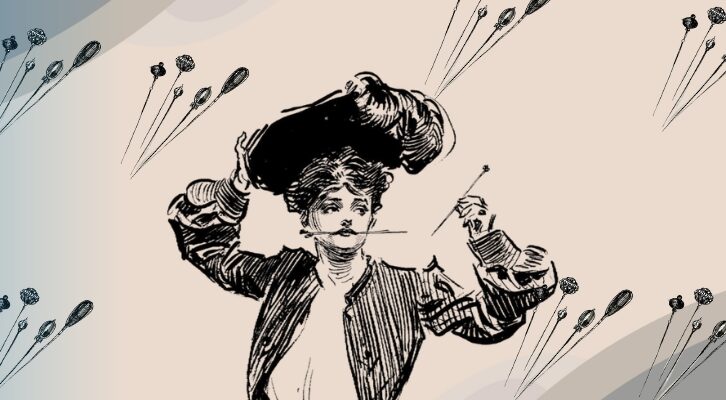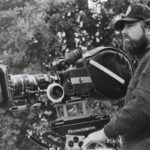
In Teaching Stories of Disaster, Hope Lies Hidden in Plain Sight
Jane Costlow on Learning at a Distance During a Pandemic
The murmurs ebb; onto the stage I enter.
I am trying, standing in the door,
To discover in the distant echoes
What the coming years may hold in store.
–Boris Pasternak, “Hamlet” (from the poems of Yurii Zhivago, trans. Ann Pasternak Slater
*
One sunny, almost-spring day last week I was out walking in my Maine neighborhood; various neighbors in side yards were either raking leaves or shifting around piles of almost-melted snow. One of them greeted me as I passed and remarked that coronavirus was a “sign from above” that we need to live better lives. His view would be shared by many who over millennia have tried to make sense of the suffering that comes with monumental disruption. The claim that there is no such thing as a natural disaster rightly asks us to consider how differential responses and pre-existing infrastructures make a huge difference—but perhaps downplays the extent to which nature does, after all, play a starring role. And not just, as some nature writers might have us think, as a mode of consolation, but as the evil star, the dis-aster, the killer.
How do we tell the stories of disaster?
That is the question du jour, and it’s also the question I put before my group of 28 undergrads in January, when we embarked on what would be my last time teaching a class I call Catastrophes and Hope at Bates College in Lewiston, Maine. The college is a residential liberal arts school with about 2,000 students. Most of the kids in my class are environmental studies majors, with a few from psych and lit thrown in. With the possible exception of the two aspiring writers in the bunch, I’m not sure they knew what they were in for.
“Environmental Studies” after all can suggest something vaguely policy-oriented, providing aspiring greens with tools for social change, an understanding of the basics of ecology, some key terms like Anthropocene and resilience. Cost benefit analysis and GIS. But my background is in Russian lit, and Catastrophes and Hope has become more adamantly humanistic the longer I’ve taught it. I’ve wanted them to read poetry, not policy. The work we engage with offers up voices of pain, rage and longing, testimony at least as important as the work of theorists and planners.
We start with Noah, not just in the Genesis version but in the Koran and a feminist midrash that is one long lamentation (all those dead bodies, floating in the surrounding sea: even medieval icons urge that anguish). We move on to modern inundations and arks: The Day After Tomorrow, whose Hollywood aesthetic we all blithely critiqued, particularly the ridiculously rapid onset of a world-changing disaster (a week! How silly!). We read Candide, Leslie Marmon Silko’s Ceremony, Doctor Zhivago (how much pain—environmental, human, cultural—do civil wars rain down on the heads of the innocent?); and then Svetlana Alexievich’s magisterial Voices from Chernobyl. We finish with Spike Lee’s When the Levees Broke.
People in extraordinarily constrained political and economic conditions make lives of dignity, lives inflected with moments of joy and commitment.
It’s a syllabus filled with legends, warnings, trauma; war, dismemberment, famine; lyrical horror, a bit of humor, and pithy take-homes, including this gem from Voltaire, spoken to Candide by a man in Surinam, about how he lost his limbs to a slave master: “It’s the price I pay for the sugar you love to eat.” Indeed.
This is, however, the first time I’ve had to contend with disaster in the midst of teaching a course on the topic. Social scientists think about “hazards” (naturally occurring, things like fire or flood that can be essential parts of ecosystems) and how they become disastrous for humans, plotting how environment and social relationships all play into vulnerability. As [the geographer] Nigel Clark puts it in Inhuman Nature, “what are catastrophes for soft, fleshy creatures like us are for the earth merely minor and mundane readjustments.” The word itself—dis-aster—has something to do with stars, with being born under a bad one. It’s a view of the catastrophic that has more to do with fate than human foibles.
When the college went to distance-learning in mid-March, I had decisions to make about transitioning to a kind of teaching I’d never done before. Given the size of my classes, and the geographical spread of where students live, I opted against what we’re calling “synchronous” classes on line: instead I made short video presentations that students can watch at their own convenience, and then split the class into groups of seven or eight students. They meet twice a week to discuss readings, and someone posts for the group on our course blog. I’ve also asked them to write individual posts that can be about anything.
 Professor Costlow on the last day of classes before Bates College closed down because of the coronavirus pandemic. Photo: Phyllis Graber Jensen/Bates College.
Professor Costlow on the last day of classes before Bates College closed down because of the coronavirus pandemic. Photo: Phyllis Graber Jensen/Bates College.
The individual posts are what has been most interesting to me: the writing has become more informal and also more observant. It is often deeply moving, sometimes melancholy, sometimes wry and self-deprecating. They write about time, and disappointment. They write about being bored; about loving their families and being annoyed with them. They write about trees coming into blossom, and slow internet, but they also write about fear, and having to work, and family businesses that must close; they worry about parents who work at hospitals, and elderly grandparents, and whether or not they’ll be able to afford Bates come fall. I’ve asked two students for permission to use quotes from their blog posts:
One student says that amidst the feeling of being “stuck” she’s been “working to mindfully change this mindset of stuckness” into something like safety. “Rather than saying I’m stuck at home I encourage myself to say I’m safe at home.”
Another writes of worrying about a grandmother he calls Big G “for sass.” “She told me that she made a collage. It spelled hope. Her nursing home has been infected by the virus. I cried.”
Through all this, the formality and caution of our “normal” classroom has begun to erode. We peer into each other’s bedrooms, family pets join class, I see other members of the household moving in the background, we share recipes and news about the weather. Students who had never spoken in class now participate in their zoom square, and make interesting observations on the blog. It’s not all great, by any means. There are students who are no-shows, as there were before. It’s harder to focus on a common text, to sustain conversation and push deeper into the meaning of an image or passage…
Hope is everywhere in these stories, lying hidden in plain sight… But the frisson of disaster is enticing, and so we head toward the edge of the cliff.
One day we stage a reading of Alexievich’s Voices From Chernobyl, with each student sharing a section they’ve chosen and rehearsed. The point isn’t to offer commentary, but simply to bring these voices into our shared audio space, to inhabit someone else’s moment of attenuation and confusion. In an essay called “Confronting the Worst: Writing and Catastrophe,” Alexievich talks about her books as “novels of voices.” As she wrote her books on Chernobyl and Soviet experiences of war, she “began to understand that what I was hearing people say on the street and in the crowds was much more effectively capturing what was going on than anything I was reading in print.” My hope is that her symphony of “human feelings and human turmoil” might help us find our own voices.
I originally started teaching the course because I was tired of hearing environmentalists say that climate change was so unprecedented that no previous human experience was relevant to dealing with it. My experience of life first in the Soviet Union and then in post-Soviet Russia had convinced me of the opposite: that people in extraordinarily constrained political and economic conditions make lives of dignity, lives inflected with moments of joy and commitment. I wanted my students to read a book like Zhivago because it’s about a society that comes apart, lives that are profoundly—viciously—unsettled, and yet there are forms of endurance, too.
Over the years I’ve taught Pasternak’s novel I’ve come increasingly to appreciate just how dark the novel’s vision is, how much violence and suffering it contains. The book begins with a funeral and the boy Zhivago standing on his mother’s grave, howling like a young wolf. The liturgical ritual of burial is interrupted by something feral and raw. It’s not just revolutions that interrupt human culture. The boy who will become a poet howls like a peasant woman. Maybe this is what death teaches us: to howl our way beyond cliché and false comfort.
The course discussions have never focused much on hope; it’s the easiest part of the course to ignore, despite my urging that we consider George Frederick Watt’s haunting painting of a masked woman and her stringless harp. The image hung in Nelson Mandela’s cell, and led Obama to title his memoir The Audacity of Hope. I try to convince my students that hope is everywhere in these stories, lying hidden in plain sight… But the frisson of disaster is enticing, and so we head toward the edge of the cliff, in the company of various idiots and saints, whose lives (thank God!) we don’t actually have to live.
The experience of teaching about disaster in disaster, distanced but strangely intimate, reminds me of what teaching can be.
This semester I invited students to write on resilience in Zhivago: one of the students who took the prompt produced a remarkably moving paper, insisting that there’s nothing remotely like resilience in the novel. Nature may continue, but humans are unfaithful and die; the only ones left in a destroyed village are those near death themselves. Maybe this student’s resistance to the word is in fact something to feel hopeful about (the novel speaks powerfully to the catastrophe of political rhetoric). Pace my student, there is hope, maybe even resilience, in Zhivago’s world: it’s just not pretty. It’s Voltaire’s resilience, not Pangloss’s, born of bitter experience.
There are of course vast differences between this moment and almost every disaster we’ve read about over the past three months. My house has not sustained weeks of high water; there has been no earthquake; I have not been ordered to gather my belongings and leave forever the house in which I’ve raised my children; crowds have not gathered to burn at the stake or otherwise attack miscreants held responsible for the current suffering. My pantry is well stocked; I have a house full of books, a neighborhood to walk in, technology that brings me into the homes of my friends. But something has been disrupted, and something beyond death and economic decline might come of this moment.
This is my last term teaching, so I won’t be returning next fall to a classroom. If I did have more semesters ahead of me I hope I would resist returning to something called “normal.” Zhivago returns from WWI to a Moscow on the eve of revolution; he longs for the life he’d lived before, but it is not to be. What might teachers learn from this moment of what is called “distance” learning, brought about because we’ve been reminded that in some sense there is no such thing as distance? My students are grappling with the existential realities of texts that have always seemed to be about some other life: maybe what’s needed isn’t a different body of stories, but a new way of reading them, of entering into their realities and making them our own… Time, horror, impatience, what nature offers us and what it doesn’t and in fact can’t.
In early April I had a three-act dream about my Bates colleagues, some living and some dead, who visited me in different rooms. One of the rooms is a vast but overly full storehouse, a kind of machine shop with hanging fluorescent lights. My desk is in a dusty, airless corner. The next room is smaller, and has a big round table and a four-poster bed. The final room is actually a transplant from my childhood home, with a big open archway between rooms, a row of potted flowering plants sitting on the floor where the rooms meet. Even before the coronavirus too much of my life as a teacher felt like living in a machine shop; even at a place as well-heeled as my college, the classes are too big, and the students too often are looking for tools instead of questions. Too many of our conversations feel abstract, not connected to human experience and intuition.
But paradoxically enough, this experience of teaching about disaster in disaster, distanced but strangely intimate, reminds me of what teaching can be—what teaching could and must be, if we hope to avoid the worst repercussions of the inevitable evil stars of our future. Zhivago and his family planted potatoes in well-composted ground, and in the evening they read novels and talked about them. People who survived Chernobyl became mystics convinced that we must change our relationship with the more-than-human world. The men and women who survived Katrina speak now with blistering clarity about the forces that undid their lives.
We have always existed within this symphony of voices, stretching all the way back in time. Candide can get to the garden only by leaving his sheltered home, following the path of misery and mischief to its end. Where do we head when this thing ends, when we encounter the sign post that instead of Catastrophe reads “Hope”? These voices urge audacity, and perseverance.
Jane Costlow
Jane Costlow holds a Ph.D. in Russian literature from Yale, and teaches Russian literature and environmental humanities at Bates College in Maine. She has won awards for both her scholarship and translation, including Heart-Pine Russia: Walking and Writing the Nineteenth Century Forest (Cornell) and The Tragic Menagerie, a collection of interlinked short stories by Lydia Zinovieva-Annibal (Northwestern).



















